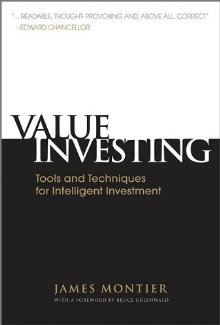Concur Technologies Cannot Grow Fast enough to Catch up to its Price
Montier, in his Value Investing, made a spirited defense of value investing by demonstrating, not only that it works in a normal market, but also, based on the history of Japan, that it works effectively in a lost decade scenario. I find this significant because it strikes me that the United States faces a significant probability of facing such a scenario. Sadly, Montier couldn’t prove that value investing worked in a Great Depression scenario, which would make me feel better. But at any rate, a value strategy, he calculated, produced 3% annual returns in a period with very low inflation, when buy and hold returned -4% over the same period. But a long value/short strategy beat the pants off of both of them: 12%.
 His book also contained advice about how to find a good short candidate. He expressed skepticism in the price/sales ratio, which he considers a transparent attempt to move up the income statement until something looks good. Perhaps the best that can be said about price/sales ratio is that it ignores both profit margins and capital structure. For example, Bon-Ton department stores has a price/sales ratio of 0.05, but since virtually all of its earnings are eaten up by interest, the stock is still highly unattractive.
His book also contained advice about how to find a good short candidate. He expressed skepticism in the price/sales ratio, which he considers a transparent attempt to move up the income statement until something looks good. Perhaps the best that can be said about price/sales ratio is that it ignores both profit margins and capital structure. For example, Bon-Ton department stores has a price/sales ratio of 0.05, but since virtually all of its earnings are eaten up by interest, the stock is still highly unattractive.
But even if a low price/sales ratio does not necessarily indicate an attractive buy, an astronomically high price/sales ratio might well indicate an attractive short. Montier’s book includes a quote from Sun Microsystem’s own CEO to the effect that his firm was too expensive at a price/sales ratio of 10. The CEO stated that this lofty valuation assumes that his company purchases no raw materials or capital, that his staff works for free, and that despite his company not buying anything or paying anyone, it pays no taxes.
In this vein, I am pleased to present Concur Technologies (CNQR) as a short selling candidate. I hope I shan’t be accused of piling on, but the apparent level of optimism around this stock seems to have surpassed unrealistic and moved on to fanatical. The company has a price/sales ratio of 9.4 and a P/E ratio of 117. True, they have produced five year earnings growth of 33% per this article at Motley Fool, but the question then becomes how many years they can sustain that level of earnings growth, and how many years they have to sustain it in order to justify their current valuation.
Fortunately, Damodaran, in Damodaran on Valuation, has given us a formula for evaluating companies that are currently growing at faster than stable rates. The H Model described in his book assumes that a company that is now growing at a high rate will see its growth rate decay in a linear fashion to a stable growth rate. It may be objected that most growth companies do not actually show a linear decay in earnings growth rate, and I must say that I agree with that sentiment: growth usually decays in a faster than linear manner. In The Dark Side of Valuation, Damodaran calculates that even starting from the IPO, median growth levels decay exponentially until by year 6 the company’s growth rate is indistinguishable from the other companies in its sector.
The H model, in case you were wondering, is price = e*(1 + g)/(K-g) +e*H(G – g)/(K – g), where
e = current earnings
g = long-term stable growth rate
G = initial high growth rate
K = required return on equity investments
H = half the number of years until stable growth rate is reached.
It’s not the most sophisticated formula, but it does give you a rough idea of what the market is expecting, and is not calculation-intensive enough to be inconvenient.
 So, Concur’s current earnings per share are 44 cents, but they did record a significant noncash interest expense of $2.5 million relating to their convertible debt, so if we put that back in the earnings improve to 49 cents. Let us further assume that the high growth rate of 33% holds true, and that the long-term growth rate is 6%. This is not unreasonable since it includes inflation as well as economic growth. It is optimistic, but when we consider short candidates we want to make optimistic assumptions, just as when we want to value longs we want to make conservative assumptions.
So, Concur’s current earnings per share are 44 cents, but they did record a significant noncash interest expense of $2.5 million relating to their convertible debt, so if we put that back in the earnings improve to 49 cents. Let us further assume that the high growth rate of 33% holds true, and that the long-term growth rate is 6%. This is not unreasonable since it includes inflation as well as economic growth. It is optimistic, but when we consider short candidates we want to make optimistic assumptions, just as when we want to value longs we want to make conservative assumptions.
Assume further that the high growth period will last six more years, and that we have a required return on equity investments of 10%. This gives us $22.91, which is less than half of the current share price.
Now, as I said, the H model gives us an idea of what the market is expecting, so let us solve for what the market actually is expecting. If the market accepts 33% as the high growth rate, for example, how long is the market expecting the company to go before it drops to stable growth? Using the H formula, we find that the market expects the high growth period to last 23 years, which, considering that 6 or less is more common, strikes me as somewhat unlikely. It assumes that even nine years from now they will still be producing 20% growth.
Or, we could assume that the six years is correct, but that the company is entitled to a higher high growth rate. Keeping everything else constant and using a six year assumption, we find that the market is expecting earnings growth rates of 109%, meaning that the firm will double its earnings growth next year, nearly double them again the year after that, make a further increase of almost 3/4 the year thereafter, and so forth. I find this outcome also highly unlikely.
If we take a hybrid assumption of 50% for the high growth rate and 10 years of excess growth, we still get only $39.44, about 23% below the current share price. So, even results that most companies would kill for would not be good enough to justify buying Concur at its current price.
 But perhaps there is something about Concur that makes it so interesting. Its primary line of business is automating tracking and reimbursement of employee spending on matters such as business travel. Increased automation of these processes decreases both time expended and error rates, as it tends to cut down on businesses using the manila-envelope-full-of-receipts method of filing. However, it does not appear to me that they have any sort of defense from the competition; expense management software is not so unique, and even if their software-as-a-service model allows them more flexible pricing given the needs of their customers, their competition could take advantage of the same service.
But perhaps there is something about Concur that makes it so interesting. Its primary line of business is automating tracking and reimbursement of employee spending on matters such as business travel. Increased automation of these processes decreases both time expended and error rates, as it tends to cut down on businesses using the manila-envelope-full-of-receipts method of filing. However, it does not appear to me that they have any sort of defense from the competition; expense management software is not so unique, and even if their software-as-a-service model allows them more flexible pricing given the needs of their customers, their competition could take advantage of the same service.
Furthermore, and perhaps more disturbing given the hyper-growth thesis that the market currently holds for Concur, their growth seems to have hit a ceiling. Between 2007 and 2008, sales nearly doubled and profits more than doubled. Between 2008 and 2009, sales increased by over 15%, from $206 million to $239 million, and net income increased by a little under 50%, from $17.2 million to $25.7 million. However, 2010 year to date, sales have increased an additional 18%, and yet income to date, even putting back the noncash interest expense, has in fact declined slightly as compared to last year.
Furthermore, one aspect of the company that gives me further concern on the long side is that more than half of the company’s assets, $550 million out of $950 million total, consists of cash and short term investments. It seems to me that a bona fide growth company should be able to find a better use for its money than just sitting on it. The company’s return on non-cash assets is a robust but not too outsized 7%, so if all their cash was in fact converted into usable assets earnings would theoretically more than double. So, the fact that this has not occurred would only be because the firm has not yet found the customers to allow it. And even if it did occur, this trick would double earnings once but not twice.
As a final aside, I will note that the firm has outstanding $285 million in outstanding convertible bonds, an additional 5.4 million shares, or roughly 10% of total shares outstanding, that are bumping against the conversion price. Curiously, the firm purchased roughly 5 million shares worth of call options on itself to offset the effect of the bonds converting, and the $60 million in options premiums sort of defeats the purpose of saving money by issuing convertible debt, or so it seems to me.
The only thing missing from making Concur into the perfect short is a catalyst. The company’s interest requirements are covered by about nine times, so there is no apparent risk of distress. The only real problem with this company is the price, and, sadly for shorts, overvaluation can persist for some time. However, given the massive levels of growth required to make the current share price have any semblance of logic, it strikes me as unlikely that the company can pull it off, particularly if competition starts sniffing around. And so, I would conclude that Concur Technology is an attractive short candidate.
Leave a Reply